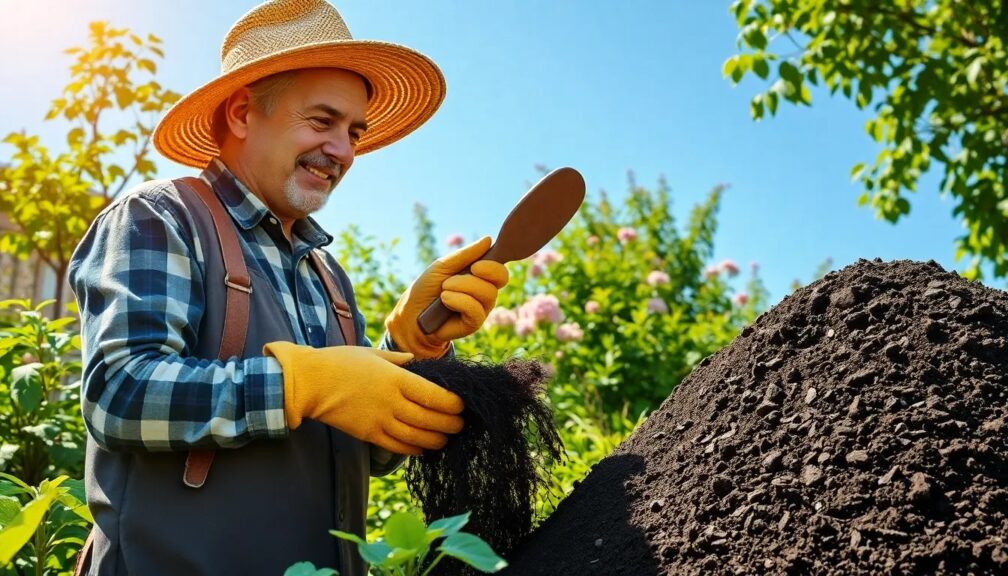Should you till compost into the soil

Welcome to Our Comprehensive Guide on "Should You Till Compost Into the Soil"
Exploring the best practices for incorporating compost into your garden beds is essential for any gardener looking to enrich their soil and boost plant health. Tilling compost into the soil has long been a traditional method for gardeners to improve soil structure, fertility, and aeration. However, with the rise of no-till gardening methods and a growing awareness of soil ecology, the question arises: is tilling compost truly beneficial? In this article, we delve into the pros and cons of tilling compost into the soil, examining its impact on soil health, plant growth, and the environment. Whether you're a seasoned gardener or a green-thumbed novice, join us as we unearth the truths behind this common gardening practice and help you make an informed decision for your garden.
Does compost need to be tilled in?
Imagine transforming your garden into a lush, vibrant haven of growth and bounty. The secret lies within the dark, rich substance we call compost. But there's a burning question that often goes unanswered for many garden enthusiasts: how to effectively incorporate this 'black gold' into your soil. It's not just about piling it on; it's about unlocking its full potential.
Should you simply scatter it across the surface, or is there more to it? The truth is, the method you choose can have a significant impact on the health of your garden.
First off, let's talk about the magic of compost. It's teeming with nutrients and microorganisms essential for plant growth. But if it just sits on the surface, are you truly reaping all the benefits? On the other hand, tilling can seem like a laborious task. So, what's the best course of action?
The answer might surprise you, as it breaks away from traditional gardening dogma. By exploring the pros and cons of tilling compost into the soil, one can discover a path that not only preserves soil structure but also maximizes the efficacy of compost.
Consider this - non-tilled gardens maintain their natural layers, which is great for soil health and microbial activity. Yet, without proper compost integration, are we leaving a banquet of nutrients just out of our plants' reach? The key is to find a balance, a method that satisfies both the soil's and plants' needs without causing undue disruption.
In the upcoming sections, we delve into the nitty-gritty of compost integration. We'll explore how techniques such as top-dressing or using no-dig gardening methods can be just as effective, if not more so, than traditional tilling.
Stay tuned to unlock the mysteries of effective compost use and elevate your gardening game to new heights. Your garden's transformation awaits, and the path to that success is right at your fingertips. Are you ready to embark on this journey and uncover the ultimate composting strategies that could revolutionize your garden?
Should I till compost into soil?
The integration of compost into soil is a game-changer for any gardening enthusiast, novice, or professional. Tilling compost into your soil is not just a mere action; it's an initiation into a world of enhanced soil fertility and a gigantic leap towards sustainable gardening practices. But hang on, before you grab that spade, let's delve into the heart of the matter.
When we talk about composting, we're discussing the ultimate recycling project, turning your kitchen scraps and yard waste into black gold for your garden. However, the real magic happens when this rich, organic material meets soil. The act of tilling itself may seem archaic, yet it serves a purpose that modern gardening cannot ignore. It's about creating the perfect marriage between compost and soil, a union from which your plants will greatly benefit.
Imagine your garden thriving with verdant plants, fruits bursting with flavor, and vegetables that are the envy of your neighbors. This is the potential that lies in the methodical mixing of compost into the very foundation of your garden. But the question remains: how can this process affect your soil structure, aeration, and overall plant health?
Mystery surrounds the topic, but what is clear is that the introduction of compost can invigorate soil life, increasing the presence of beneficial microorganisms and earthworms. These little workers are your unseen allies in the quest for garden supremacy. Yet, there's a catch—the technique you use can have profound implications.
To till or not to till? That is the question stirring in the minds of many gardeners, with arguments on both sides of the fence. While some advocate for the traditional approach, others suggest that no-till methods can be just as effective. It's a debate that could change the way you interact with your garden forever.
Delving into the whens, hows, and whys of tilling compost into soil will unlock secrets that could transform your garden. Think about nutrient cycles, water retention, and the delicate balance of your garden's ecosystem—it's all up for grabs when you decide on your approach.
So, do you want to know the ultimate techniques for integrating compost into soil? Are you ready to discover the best practices that could lead to the lushest garden on the block? Stay tuned as we uncover the answers that could revolutionize your gardening experience.
How much compost to till into soil?
Imagine unlocking the secrets to a flourishing garden that turns every head in your neighborhood. The key lies beneath your feet – in the alchemy of compost and soil. But there's a catch: too little, and your garden starves; too much, and you might just smother its potential. The sweet spot? It's not just about quantity; it's about precision and timing.
Transform your garden into a verdant paradise by mastering the correct amount of compost to incorporate into your soil. The golden rule is a ratio that seasoned gardeners swear by, and it's one that could elevate your gardening game to legendary status.
For your everyday gardening enthusiast looking to enhance soil health, a mere 1 to 3 inches of compost mixed into the top 6 to 8 inches of soil is a game changer. But for those embarking on the journey of large-scale landscaping or looking to revive a desolate patch, a deeper understanding of compost ratios is paramount.
The secret to a bountiful harvest and an envy-inducing lawn isn't just in the quantity of compost, but in the quality of your mixture. Organic matter, nutrient balance, and the existing soil condition all play pivotal roles in this garden drama.
Ready to dive deeper into the world of compost and soil? Discover the tricks to achieve that perfect blend – the one that will foster unparalleled growth and breathe life into your plants. Unearth the knowledge that will transform your green spaces and make the mere act of gardening an act of pure alchemy. Your journey to becoming the master of your garden is just beginning, and the next chapter promises a tale of growth, balance, and lush abundance.
How long should you let compost sit before planting?
The secret to a lush, vibrant garden or a yield of bumper crops lies within the quality of your soil. And what's one of the best ways to enrich that soil? Composting. But if you're eager to turn your kitchen scraps and yard waste into black gold, there's a crucial period you can't ignore—the curing time of compost.
The answer isn't as straightforward as you might hope. Depending on various factors such as the material composition, climate, and composting method, the perfect timing can range from as little as a few weeks to several months.
Consider this: compost that sits undisturbed for an optimal period undergoes a transformation that can unlock nutrients, improve soil structure, and enhance water retention. Rushing the process can lead to incomplete decomposition, which might attract pests or harm your plants.
Now, you might be itching to know the magic number—the exact number of days or weeks you have to wait to harness the full potential of your compost. What if there's a way to figure out the precise moment your compost is ready to work wonders in your garden? And what if by learning this, you could avoid the common pitfalls that could set your garden back?
Stay tuned to uncover the signs of perfectly cured compost and the techniques to accelerate decomposition while maintaining the integrity of your future soil amendment. The answer is closer than you think, and the results? They could transform your gardening experience forever. Don't miss out on the chance to give your plants the ultimate growth foundation. Your garden's success story starts with understanding the art and science of composting timing.
Should you till compost into the soil reddit
Discover the secrets of soil enrichment that savvy gardeners are discussing right now. Imagine unearthing the hidden benefits of working compost into your garden beds. We're talking about the potential to supercharge plant growth, enhance soil fertility, and foster a thriving garden ecosystem.
But wait, there's a twist! The method you choose to integrate compost into your soil could make all the difference. Some gardeners swear by tilling, while others advocate for a no-till approach. What they aren't telling you upfront could be the game-changer for your gardening success.
Tilling:
1. Traditionally, tilling has been heralded for its ability to mix compost evenly, promoting aeration and water infiltration.
2. However, tilling can also disrupt soil structure, harm beneficial organisms, and lead to erosion.
No-Till:
1. On the flip side, the no-till movement emphasizes minimal disturbance, keeping the soil's intricate web of life intact.
2. By layering compost on top, you could be supporting a healthier, more resilient soil ecosystem.
So, what's the verdict? Are you potentially sacrificing long-term soil health for short-term gains by tilling? Could the no-till method unlock a garden utopia you've been dreaming about? The debate is real, and the answers might just redefine your gardening practices.
Join the conversation as we dig deeper into the soil's mysteries. Don't let the opportunity slip through your fingers like fine loam. Get ready to transform your garden narrative and become part of the soil revolution. The earth beneath your feet is whispering its secrets, and it's time to listen.
Consejo final: To maximize the benefits of compost in your garden, gradually till it into the topsoil to a depth of about 4-6 inches. This will help to enrich the soil, improve drainage, and provide essential nutrients for plant growth. Remember to allow the compost to fully mature before incorporating it into your garden to avoid any potential issues with unfinished decomposition. Happy gardening, and may your efforts yield a bountiful harvest!
 How do you loosen compacted soil without tilling
How do you loosen compacted soil without tilling How do I fix hard soil in my garden
How do I fix hard soil in my garden How do you break up hard compacted clay soil
How do you break up hard compacted clay soil Should you pack down soil when planting
Should you pack down soil when planting What is the best tool for breaking up clay soil
What is the best tool for breaking up clay soilIf you want to know more about similar articles like Should you till compost into the soil you can visit category Gardening Tools.
Deja una respuesta